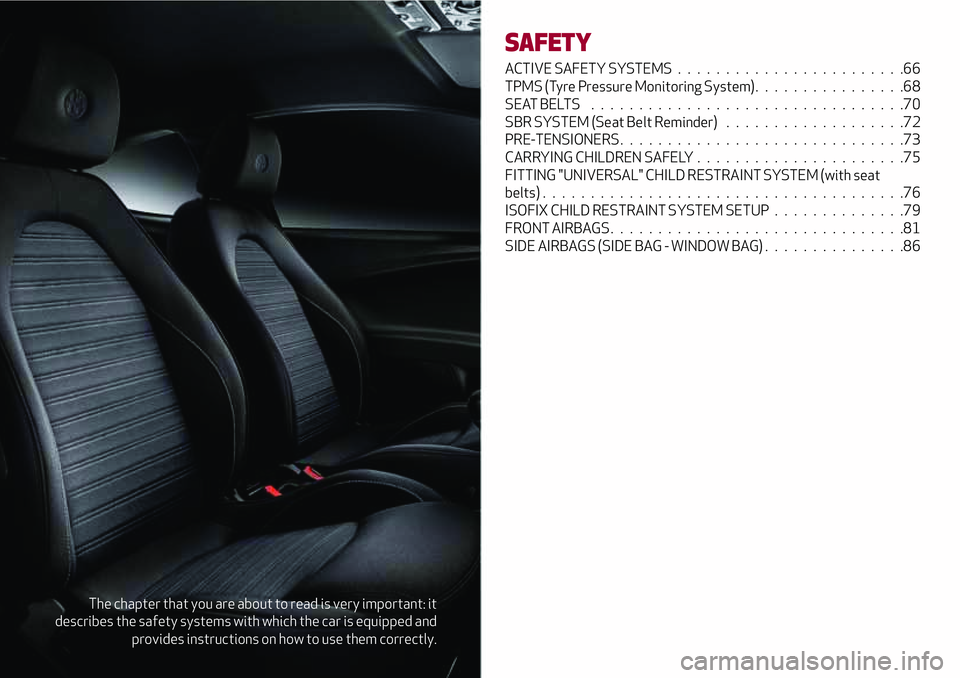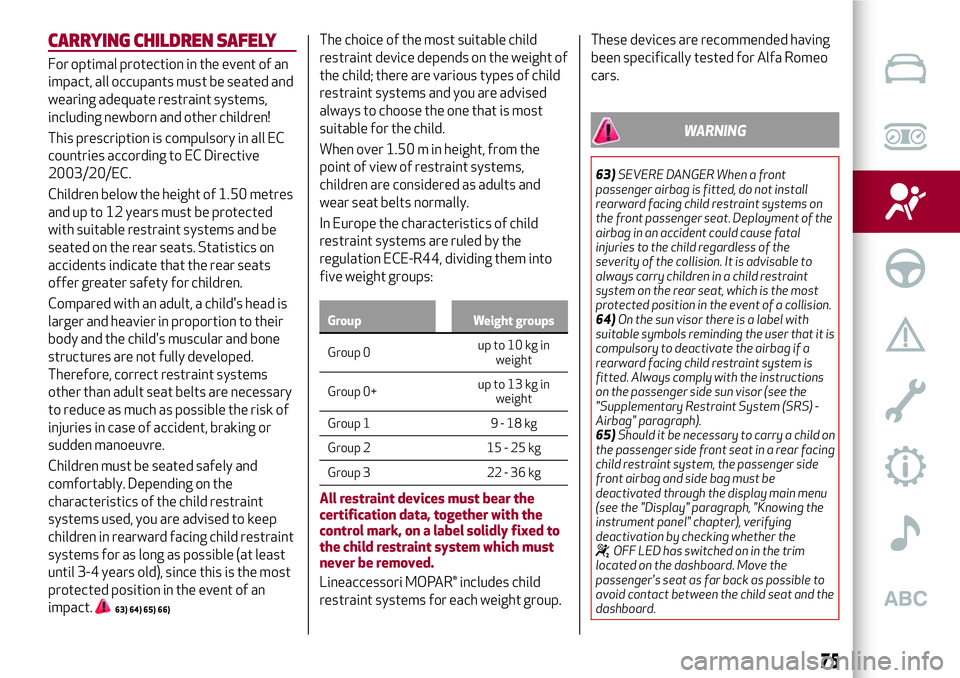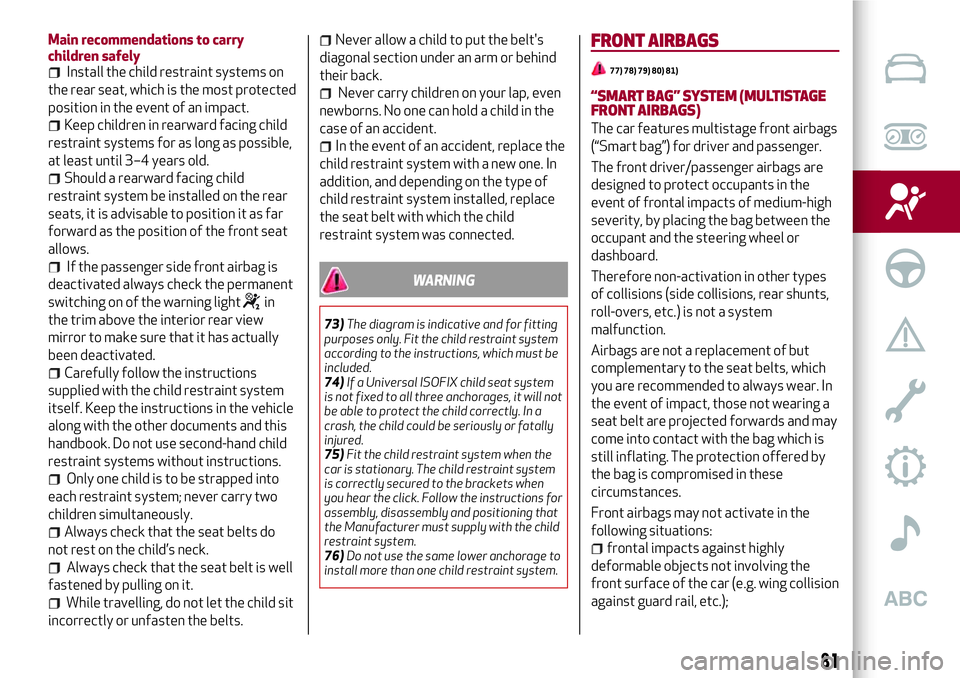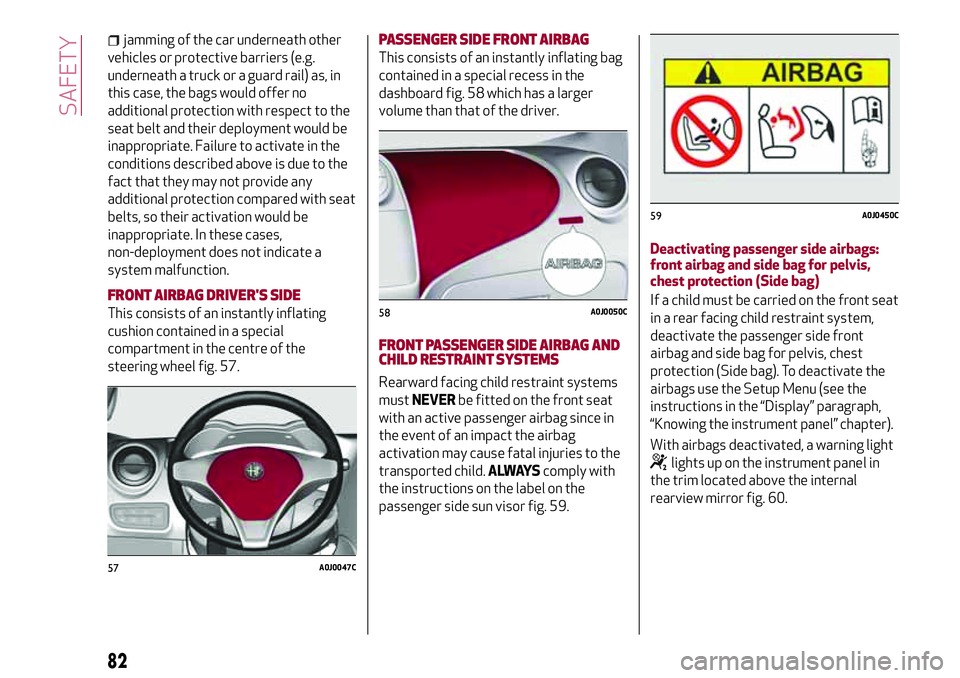child restraint Alfa Romeo MiTo 2019 Owner handbook (in English)
[x] Cancel search | Manufacturer: ALFA ROMEO, Model Year: 2019, Model line: MiTo, Model: Alfa Romeo MiTo 2019Pages: 212, PDF Size: 5.18 MB
Page 67 of 212

The chapter that you are about to read is very important: it
describes the safety systems with which the car is equipped and
provides instructions on how to use them correctly.
SAFETY
ACTIVE SAFETY SYSTEMS . . . . . . . . ................66
TPMS (Tyre Pressure Monitoring System) ................68
SEATBELTS .................................70
SBR SYSTEM (Seat Belt Reminder) . . . . ...............72
PRE-TENSIONERS . .............................73
CARRYING CHILDREN SAFELY . . . . . .................75
FITTING "UNIVERSAL" CHILD RESTRAINT SYSTEM (with seat
belts)......................................76
ISOFIX CHILD RESTRAINT SYSTEM SETUP . . . . . . . . . . . . . .79
FRONT AIRBAGS . . .............................81
SIDE AIRBAGS (SIDE BAG - WINDOW BAG) . . . . . . .........86
Page 77 of 212

CARRYING CHILDREN SAFELY
For optimal protection in the event of an
impact, all occupants must be seated and
wearing adequate restraint systems,
including newborn and other children!
This prescription is compulsory in all EC
countries according to EC Directive
2003/20/EC.
Children below the height of 1.50 metres
and up to 12 years must be protected
with suitable restraint systems and be
seated on the rear seats. Statistics on
accidents indicate that the rear seats
offer greater safety for children.
Compared with an adult, a child's head is
larger and heavier in proportion to their
body and the child's muscular and bone
structures are not fully developed.
Therefore, correct restraint systems
other than adult seat belts are necessary
to reduce as much as possible the risk of
injuries in case of accident, braking or
sudden manoeuvre.
Children must be seated safely and
comfortably. Depending on the
characteristics of the child restraint
systems used, you are advised to keep
children in rearward facing child restraint
systems for as long as possible (at least
until 3-4 years old), since this is the most
protected position in the event of an
impact.
63) 64) 65) 66)
The choice of the most suitable child
restraint device depends on the weight of
the child; there are various types of child
restraint systems and you are advised
always to choose the one that is most
suitable for the child.
When over 1.50 m in height, from the
point of view of restraint systems,
children are considered as adults and
wear seat belts normally.
In Europe the characteristics of child
restraint systems are ruled by the
regulation ECE-R44, dividing them into
five weight groups:
Group Weight groups
Group 0up to 10 kg in
weight
Group 0+up to 13 kg in
weight
Group 1 9 - 18 kg
Group 2 15 - 25 kg
Group 3 22 - 36 kg
All restraint devices must bear the
certification data, together with the
control mark, on a label solidly fixed to
the child restraint system which must
never be removed.
Lineaccessori MOPAR® includes child
restraint systems for each weight group.These devices are recommended having
been specifically tested for Alfa Romeo
cars.
WARNING
63)SEVERE DANGER When a front
passenger airbag is fitted, do not install
rearward facing child restraint systems on
the front passenger seat. Deployment of the
airbag in an accident could cause fatal
injuries to the child regardless of the
severity of the collision. It is advisable to
always carry children in a child restraint
system on the rear seat, which is the most
protected position in the event of a collision.
64)On the sun visor there is a label with
suitable symbols reminding the user that it is
compulsory to deactivate the airbag if a
rearward facing child restraint system is
fitted. Always comply with the instructions
on the passenger side sun visor (see the
"Supplementary Restraint System (SRS) -
Airbag" paragraph).
65)Should it be necessary to carry a child on
the passenger side front seat in a rear facing
child restraint system, the passenger side
front airbag and side bag must be
deactivated through the display main menu
(see the "Display" paragraph, "Knowing the
instrument panel" chapter), verifying
deactivation by checking whether the
OFF LED has switched on in the trim
located on the dashboard. Move the
passenger's seat as far back as possible to
avoid contact between the child seat and the
dashboard.
75
Page 78 of 212

66)Do not move the front or rear seat if a
child is seated on it or on the dedicated child
restraint systemFITTING "UNIVERSAL" CHILD
RESTRAINTSYSTEM (with seat
belts)
GROUP 0 and 0+
68) 69) 70) 71) 72)
Babies up to 13 kg must be carried with a
rear facing child restraint system of a
type as shown in fig. 50 which, supporting
the head, does not induce stress on the
neck in the event of sudden
decelerations.
The child restraint system is secured by
the vehicle seat belts, as shown in
fig. 50 and it must restrain the child in
turn with its own belts.
GROUP 1
67) 68) 69) 70) 71) 72)
Children of weight from 9 to 18 kg may
be transported in forward facing child
restraint systems fig. 51.
GROUP 2
68) 69) 70) 71) 72)
Children from 15 to 25 kg may be
restrained directly by the car seat belts
fig. 52.
In this case, the child restraint system is
used to position the child correctly with
respect to the seat belts so that the
diagonal belt section crosses the child’s
50A0K0014C
51A0K0129C
52A0K0016C
76
SAFETY
Page 79 of 212

chest and not the neck, and the lower part
is snug on the pelvis not the abdomen.
GROUP 3
68) 69) 70) 71) 72)
For children between 22 kg and 36 kg,
there are dedicated restraint systems
that allow the seat belt to be worn
correctly.
The fig. 53 shows the correct child
positioning on the rear seat.
Children over 1.50 m in height can wear
seat belts like adults.
53A0K0017C
77
Page 80 of 212

PASSENGER SEAT COMPLIANCE WITH REGULATIONS ON UNIVERSAL CHILD RESTRAINTSYSTEM USE
According to the European Directive 2000/3/EC the suitability of each passenger seat position for the fixing of universal child
restraint systems is shown in the following table:
Positioning the “Universal” child restraint system
Group Weight groupsFront passenger
(*)Rear passengers (side
and central)
Airbag enabled Airbag disabled
Group 0, 0+ up to 13 kg"X" U U
Group 1 9-18 kg"X" U U
Group 2 15-25 kgUUU
Group 3 22-36 kgUUU
(*) IMPORTANT NEVER fit a rearward-facing child seat in the front passenger seat if the airbag is active. If you wish to fit a rearward-facing child seat
in the front passenger seat, first deactivate the relative airbag (see instructions in the paragraph "Supplementary protection system (SRS) –
Airbag”).
"X"= Position not suitable for children in this weight category.
U= Suitable for child restraint systems in the "Universal" category, according to European Regulation EEC-R44 for the specified "Groups".
WARNING
67)Child restraint systems with Isofix attachments are available for a safe anchoring to the seat without using the car seat belts. See paragraph
"Isofix child restraint system setup" for the fitting instructions.
68)The diagram is indicative and for fitting purposes only. Fit the child restraint system according to the instructions, which must be included.
69)When the child restraint system is not used, secure it with the seat belt or with the ISOFIX anchorages, or remove it from the vehicle. Do not
leave it unsecured inside the passenger compartment. In this way, in the case of sudden braking or an accident, it will not cause injuries to the
occupants.
70)After installing a child restraint system, do not move the seat: always remove the child restraint system before making any adjustment.
71)Always make sure that the diagonal section of the seat belt does not pass under the arms or behind the back of the child. In the event of an
accident the seat belt will not be able to secure the child, with the risk of injury, including fatal injury. Therefore the child must always wear the seat
belt correctly.
72)Incorrect fitting of the child restraint system may result in an inefficient protection system. In the event of an accident the child restraint
system may become loose and the child may be injured, even fatally. When fitting a restraint system for newborns or children, strictly comply with
the instructions provided by the Manufacturer.
78
SAFETY
Page 81 of 212

ISOFIX CHILD RESTRAINT
SYSTEM SETUP
73)
The vehicle is equipped with ISOFIX
anchorages, a new standard which makes
fitting a child restraint system quick,
simple and safe.
Traditional child restraint systems can be
fitted alongside Isofix child restraint
systems on different seats in the same
car.
As an example, fig. 54 shows an example
of a Universal Isofix child restraint
system for weight group 1.
IMPORTANT The central rear seat is not
approved for any type of Isofix child
restraint system.INSTALLING A UNIVERSAL ISOFIX
CHILD RESTRAINTSYSTEM
74) 75) 76)
Proceed as follows:
attach the seat to the lower metal
rings provided 1 fig. 55, positioned
between the backrest and rear seat
cushion, then;
secure the upper belt (available
together with the child restraint system)
to the special attachments 2
fig. 56 located in the rear part of the
backrest.It is possible to have a mixed assembly of
traditional child restraint systems and
Universal Isofix ones. Remember that
when using a Universal Isofix child
restraint system, you can only use
approved child restraint systems with
the marking ECE R44 (R44/03 or
superior) “Universal Isofix”.
The Universal Isofix “Duo Plus” child seat
is available from Lineaccessori MOPAR®.
For any further installation/usage details,
refer to the “Instruction Manual”
provided with the child restraint system.
54A0J0093C
55A0J0092C
56A0J0335C
79
Page 82 of 212

SUITABILITY OF PASSENGER SEATS FOR ISOFIX CHILD RESTRAINTSYSTEM USE
The table below shows the various installation possibilities for Isofix child restraint systems on seats fitted with Isofix attachments
in accordance with European standard ECE 16.
Weight group Child restraint system position Isofix size classRear passenger
Rear side positions
Group 0 up to 10 kg Rear facing EX
Group 0+ up to 13 kgRear facing E
X
Rear facing DX
Rear facing CX
Group 1 from 9 up to 18 kgRear facing D
X
Rear facing CX
Forward facing BIUF
Forward facing B1IUF
Forward facing AX
X Isofix position not suitable for Isofix retaining system in this weight group and/or size class.
IUF: suitable for Isofix child restraint systems to be positioned in forward facing position, universal class (fitted with third upper mounting),
type-approved for the relevant weight group.
NOTE: The other weight groups are covered by specific Isofix child restraint systems, which can be used only if specifically tested for
this vehicle (see list of vehicles provided with the child restraint system).
80
SAFETY
Page 83 of 212

Main recommendations to carry
children safely
Install the child restraint systems on
the rear seat, which is the most protected
position in the event of an impact.
Keep children in rearward facing child
restraint systems for as long as possible,
at least until 3–4 years old.
Should a rearward facing child
restraint system be installed on the rear
seats, it is advisable to position it as far
forward as the position of the front seat
allows.
If the passenger side front airbag is
deactivated always check the permanent
switching on of the warning light
in
the trim above the interior rear view
mirror to make sure that it has actually
been deactivated.
Carefully follow the instructions
supplied with the child restraint system
itself. Keep the instructions in the vehicle
along with the other documents and this
handbook. Do not use second-hand child
restraint systems without instructions.
Only one child is to be strapped into
each restraint system; never carry two
children simultaneously.
Always check that the seat belts do
not rest on the child’s neck.
Always check that the seat belt is well
fastened by pulling on it.
While travelling, do not let the child sit
incorrectly or unfasten the belts.
Never allow a child to put the belt's
diagonal section under an arm or behind
their back.
Never carry children on your lap, even
newborns. No one can hold a child in the
case of an accident.
In the event of an accident, replace the
child restraint system with a new one. In
addition, and depending on the type of
child restraint system installed, replace
the seat belt with which the child
restraint system was connected.
WARNING
73)The diagram is indicative and for fitting
purposes only. Fit the child restraint system
according to the instructions, which must be
included.
74)If a Universal ISOFIX child seat system
is not fixed to all three anchorages, it will not
be able to protect the child correctly. In a
crash, the child could be seriously or fatally
injured.
75)Fit the child restraint system when the
car is stationary. The child restraint system
is correctly secured to the brackets when
you hear the click. Follow the instructions for
assembly, disassembly and positioning that
the Manufacturer must supply with the child
restraint system.
76)Do not use the same lower anchorage to
install more than one child restraint system.
FRONT AIRBAGS
77) 78) 79) 80) 81)
“SMART BAG”SYSTEM (MULTISTAGE
FRONT AIRBAGS)
The car features multistage front airbags
(“Smart bag”) for driver and passenger.
The front driver/passenger airbags are
designed to protect occupants in the
event of frontal impacts of medium-high
severity, by placing the bag between the
occupant and the steering wheel or
dashboard.
Therefore non-activation in other types
of collisions (side collisions, rear shunts,
roll-overs, etc.) is not a system
malfunction.
Airbags are not a replacement of but
complementary to the seat belts, which
you are recommended to always wear. In
the event of impact, those not wearing a
seat belt are projected forwards and may
come into contact with the bag which is
still inflating. The protection offered by
the bag is compromised in these
circumstances.
Front airbags may not activate in the
following situations:
frontal impacts against highly
deformable objects not involving the
front surface of the car (e.g. wing collision
against guard rail, etc.);
81
Page 84 of 212

jamming of the car underneath other
vehicles or protective barriers (e.g.
underneath a truck or a guard rail) as, in
this case, the bags would offer no
additional protection with respect to the
seat belt and their deployment would be
inappropriate. Failure to activate in the
conditions described above is due to the
fact that they may not provide any
additional protection compared with seat
belts, so their activation would be
inappropriate. In these cases,
non-deployment does not indicate a
system malfunction.
FRONT AIRBAG DRIVER'S SIDE
This consists of an instantly inflating
cushion contained in a special
compartment in the centre of the
steering wheel fig. 57.
PASSENGER SIDE FRONT AIRBAG
This consists of an instantly inflating bag
contained in a special recess in the
dashboard fig. 58 which has a larger
volume than that of the driver.
FRONT PASSENGER SIDE AIRBAG AND
CHILD RESTRAINTSYSTEMS
Rearward facing child restraint systems
mustNEVERbe fitted on the front seat
with an active passenger airbag since in
the event of an impact the airbag
activation may cause fatal injuries to the
transported child.ALWAYScomply with
the instructions on the label on the
passenger side sun visor fig. 59.Deactivating passenger side airbags:
front airbag and side bag for pelvis,
chest protection (Side bag)
If a child must be carried on the front seat
in a rear facing child restraint system,
deactivate the passenger side front
airbag and side bag for pelvis, chest
protection (Side bag). To deactivate the
airbags use the Setup Menu (see the
instructions in the “Display” paragraph,
“Knowing the instrument panel” chapter).
With airbags deactivated, a warning light
lights up on the instrument panel in
the trim located above the internal
rearview mirror fig. 60.
57A0J0047C
58A0J0050C
59A0J0450C
82
SAFETY
Page 86 of 212

PASSENGER SIDE FRONT AIRBAG AND CHILD RESTRAINTSYSTEMS: IMPORTANT
62J0A0215
84
SAFETY